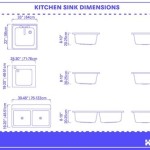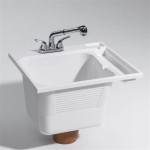Cutting a Hole in a Stainless Steel Sink: A Comprehensive Guide
Stainless steel sinks are ubiquitous in both residential and commercial kitchens due to their durability, resistance to corrosion, and ease of cleaning. However, alterations, such as adding a new faucet, soap dispenser, or instant hot water tap, often necessitate cutting a new hole in the sink. This seemingly simple task requires careful planning, the right tools, and a precise technique to avoid damaging the sink and ensuring a clean, professional-looking result. Improper execution can lead to unsightly scratches, dents, or even render the sink unusable. Therefore, this guide provides a detailed explanation of the process, covering essential preparations, tool selection, cutting techniques, and post-cutting procedures.
Before commencing any work, it is crucial to understand the properties of stainless steel. It is a relatively hard and tough material. Unlike softer metals like aluminum, it resists deformation and requires specialized cutting tools. Applying excessive force with the wrong tool can quickly dull the cutting edge, creating a rough, jagged hole or warping the surrounding area. Moreover, stainless steel generates significant heat during cutting. Without adequate cooling and lubrication, this heat can lead to discoloration and even work hardening, making the material even more difficult to cut.
Planning and Preparation
The first critical step is meticulous planning. This involves determining the precise location and size of the hole. Incorrect placement is difficult, if not impossible, to rectify. Measure the diameter of the fixture that will occupy the hole and add a small allowance, typically 1/16 to 1/8 of an inch, for ease of installation. Use a precision measuring tool, such as a digital caliper or a high-quality ruler, to ensure accuracy. Once the dimensions are established, mark the location on the sink's surface. Employ a center punch to create a small indentation at the exact center of the hole. This indentation will serve as a guide for the pilot drill bit, preventing it from wandering and ensuring an accurate start.
Protecting the sink's surface is paramount. Stainless steel is susceptible to scratches, and even minor abrasions can detract from its appearance. Apply several layers of masking tape around the area to be cut. This masking tape serves as a protective barrier, preventing scratches from the cutting tool and debris. Consider using a thicker, more robust tape designed for metalworking, as it provides better protection than standard painter's tape. Additionally, a layer of cardboard or plywood can be placed underneath the sink to catch any falling debris and prevent damage to the countertop or cabinet below.
Prior to cutting, verify that the sink is adequately supported. If the sink is already installed, ensure that the mounting hardware is secure and that the sink is not moving or wobbling. If the sink is uninstalled, place it on a stable workbench or a padded surface. This will prevent the sink from shifting during the cutting process, which could compromise the accuracy of the cut and increase the risk of injury.
Tool Selection and Techniques
Selecting the appropriate cutting tool is crucial for achieving a clean and precise hole in stainless steel. Several options are available, each with its own advantages and disadvantages. The most common tools include hole saws, step drill bits, and rotary tools with cutting discs. The choice of tool depends on the size of the hole, the thickness of the stainless steel, and the desired level of precision.
Hole saws are circular blades with teeth designed to cut through various materials. When using a hole saw, it is essential to use a bi-metal hole saw specifically designed for cutting metal. These hole saws have hardened teeth that can withstand the abrasive nature of stainless steel. Select a hole saw that is slightly larger than the required hole diameter. A pilot drill bit, located at the center of the hole saw, guides the blade and ensures accurate alignment. Begin by drilling a pilot hole using the center punch indentation as a guide. Apply steady, even pressure and use a cutting oil or lubricant to reduce friction and heat. Avoid forcing the hole saw, as this can damage the teeth and create a rough cut. Allow the hole saw to do the work, periodically removing any metal shavings from the cutting area. Once the hole is complete, carefully remove the cut-out disc from the hole saw.
Step drill bits, also known as unibits, are cone-shaped drill bits with multiple steps, each representing a different hole diameter. They are particularly well-suited for cutting holes in thin materials like stainless steel sinks. Step drill bits offer several advantages over hole saws. They produce cleaner, more accurate holes with less burring, and they are less likely to catch or snag on the material. Start with the smallest step and gradually increase the diameter until the desired hole size is achieved. Use a cutting oil or lubricant to reduce friction and heat. Apply steady, even pressure and avoid excessive speed, which can cause the bit to overheat and dull.
Rotary tools, such as Dremel tools, can also be used to cut holes in stainless steel. These tools utilize small, high-speed cutting discs designed for metalworking. While rotary tools offer versatility and maneuverability, they require a steady hand and precise control. Use a cutting disc specifically designed for stainless steel. Mark the desired hole diameter on the sink surface and carefully follow the outline with the cutting disc. Work in small increments, making multiple passes rather than attempting to cut through the entire thickness of the metal in one pass. This will reduce heat buildup and prevent the cutting disc from binding or breaking. Wear appropriate safety glasses and a dust mask to protect yourself from flying debris. Rotary tools can produce a significant amount of metal dust and sparks.
Regardless of the chosen cutting tool, maintaining a slow and steady cutting speed is essential. High speeds generate excessive heat, which can cause the stainless steel to work harden and become more difficult to cut. Apply a cutting oil or lubricant generously to the cutting area to reduce friction and heat. Cutting oil also helps to remove metal shavings from the cutting area, preventing them from clogging the cutting tool. If the cutting tool begins to bind or overheat, stop immediately and allow the tool and the sink to cool down before proceeding. This will prevent damage to the tool and ensure a clean, consistent cut.
Post-Cutting Procedures and Finishing
After cutting the hole, several post-cutting procedures are necessary to ensure a clean and professional-looking finish. The edges of the hole will likely have burrs and sharp edges, which can be dangerous and unsightly. Deburring is the process of removing these imperfections. There are several methods for deburring stainless steel, including using a deburring tool, a file, or a rotary tool with a deburring attachment.
A deburring tool is a specialized hand tool designed to remove burrs from metal edges. It consists of a handle and a rotating blade that scrapes away the burrs. Hold the deburring tool at a slight angle to the edge of the hole and rotate it along the edge, applying gentle pressure. Continue until all the burrs are removed.
A file can also be used to deburr stainless steel. Select a fine-toothed file designed for metalworking. Hold the file at a slight angle to the edge of the hole and stroke it along the edge, applying gentle pressure. Work in a consistent direction to avoid creating scratches. A rotary tool with a deburring attachment, such as a sanding drum or a grinding stone, can also be used to deburr the hole. Use a low speed and light pressure to avoid removing too much material.
Once the burrs are removed, the edges of the hole may still be rough or uneven. Abrasive pads or sandpaper can be used to smooth the edges and create a more finished look. Start with a coarse grit sandpaper and gradually progress to finer grits. Wrap the sandpaper around a small block of wood or a sanding pad to provide a flat, even surface. Sand the edges of the hole in a circular motion, applying gentle pressure. Continue until the edges are smooth and even. Polish the area surrounding the new hole to blend the finish and remove any scratches or scuff marks caused during the cutting process. Use a stainless steel cleaner and a soft cloth to polish the area.
Finally, clean the sink thoroughly to remove any metal shavings, cutting oil, or other debris. Use a mild detergent and warm water. Rinse the sink thoroughly and dry it with a clean cloth. Inspect the hole for any remaining imperfections and address them as needed. Once the sink is clean and dry, the new fixture can be installed. Ensure that the fixture fits snugly into the hole and that all connections are properly sealed to prevent leaks.

How To Drill Hole Any Sink Easy Simple

How To Drill Hole In Stainless Steel Sink Step By

Drilling Large Holes In Stainless Steel The Easy Way

How To Cut A Hole In Kitchen Sink

Step By Guide To Cutting Out A Kitchen Sink Easily

Drilling Large Holes In Stainless Steel The Easy Way Youtube

Drilling A Hole In Stainless Steel Sink With 35mm Metal Saw

Dolity Sheet Metal Hole Punch Durable Cutting Tool Cutter For Steel Plate Sink Diameter 35mm Wal Ca

How To Drill A Hole In Stainless Steel Sink Simple Easy Youtube

How To Drill Holes Into Quartz Granite Counter







